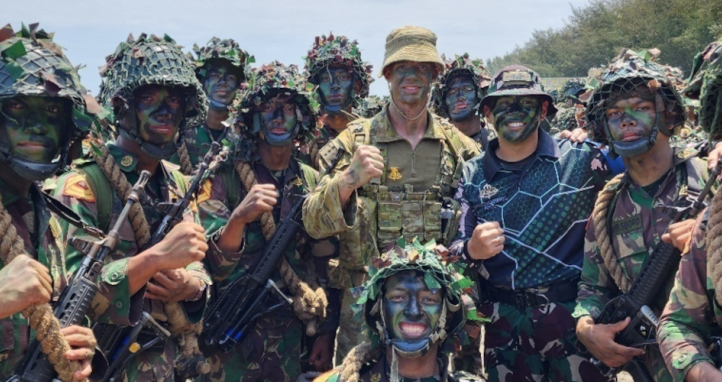My last two articles (here and here) have focused on the current deficits and challenges to the modernisation and delivery of evidenced based, professional level Strength and Conditioning (S&C) to a military population which is varied in its needs, schedules and resources. While it’s easy to point out problems from the proverbial armchair, it’s harder to be a part of the solution, and so with this article in the ‘series’ I hope to add value with an idea for the implementation of effective S&C to this population.
A Networked Approach
There are a number of difficulties in implementing a consistent standard of S&C across Army such as manning, training and resources. However I believe that an interlinked cell system would help to address a number of these problems and provide a step forward in the delivery of quality training to our increasingly professional force.
This system approach could be split into three functional levels with lines of communication between all cells. What this will allow is the concentration of effort, training and subject matter expertise, as well as preventing silos forming between different locations and organisations. This potential structure is shown below and consists of a formation level cell (strategic), brigade level cells (operational), then the end user interface of unit Combat Fitness Leaders (CFL) and soldiers conducting PT (tactical); each level has a specific focus and mandate and also provides the potential for advancement, corporate knowledge retention, personnel retention and the ongoing development of expertise.
The cells would work through a trickle down approach along these lines:
FORCOMD Cell – Strategic overview and C2
- create macro level program structures and develop training methodologies
- provide strategic level advice to command on the delivery of S&C in Army
- drive continuous professional development, and develop individuals for advancement
- remain current with latest research and development
- potential for civilian contract to bring in national/international level experts in a consultation role providing advice and education
- placements at Australian Institute of Sport or equivalent high performance centres
Brigade Cells – Local nodes
- make annual programs relevant to brigade tempo
- drive ‘brick’ approach for unit CFLs to use
- monitor data collection (for program dev and to minimise risk of injury)
- provide SME advice to units and CFLs
- collaborate with brigade rehabilitation pathway
- placements at State Institutes of Sport or sporting teams/regional high performance centres
Unit CFLs – Refine and implement to dependent Force Element
- utilise yearly and block ‘bricks’ to drive customised unit/company level training
- implement appropriate ‘bricks’ for the dependencies relevant phase
- ensure data collection occurs (app based easy to use system)
- individualise programs - intensity and volume
The system would primarily use what I call the ‘brick’ approach to deliver content from the top to the end user. In this approach the strategic level cell would utilise their SME to devise current periodised annual programs and set themes based on the force generation cycle. They would do this through the creation of ‘bricks’ which are 4-6 week program structures aimed at specific targets or phases, for example:
- return from leave phase
- return from field phase (if EX was >2weeks duration)
- build to PESA
- maintenance focus/strength focus/conditioning focus phases
- pre-deployment phase
These would provide safe, researched and effective structures to be utilised by the next level down. Importantly, this modularised or pick and play approach would help to minimise the impact of tempo on continuous goal driven training, and help combat the problem of inappropriate loading regimes during periods such as return from prolonged field time or leave. That would then be taken by the brigade cell or operational level cell and be fleshed out and customised to their locality, the brigades phase, and tempo. This cell would also aim to align these bricks into a program which flows across a 12 month training cycle. They will then pass these programs down to the end user, unit CFLs, and guide them in the implementation, monitoring and progressing of programs down to the micro or tactical level.
This approach would also offer the potential to up-skill Physical Training Instructors (PTI) posted into these positions, a training liability that has been hard to sell for the whole trade. PTIs at brigade level should begin an undergraduate degree in Exercise and Sport Science or equivalent and also achieve at least level 1 with the Australian Strength and Conditioning Association (ASCA); then at the formation level should begin studying a Masters level program and progress to at least level 2 with ASCA. This minimises the training liability but concentrates enough qualified personnel in the right place to achieve a disproportionate effect.
Recent change within Army has also delivered a potential vehicle to implement this system: the Human Performance Centres. These have begun to form within brigades and could offer an existing structure to administrate and facilitate this network approach. It is my opinion that the biggest effect available to improve human performance within Army is the implementation of a fundamental S&C culture which promotes: strength training; work specific conditioning; increased ownership of individual fitness; and a professional approach (it can’t always be fun). Any initiative that doesn’t include this is like treating a broken finger and ignoring a catastrophic haemorrhage.
Thanks again for taking the time to read this, as always looking to advance the debate and generate ideas for positive change! Stay tuned for my next oversharing moment where I’ll discuss some ideas for the use of technology for military strength and conditioning.




